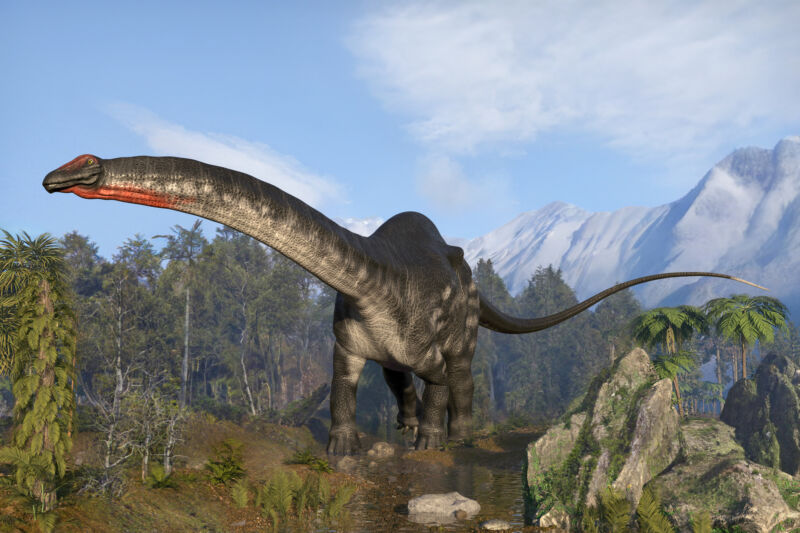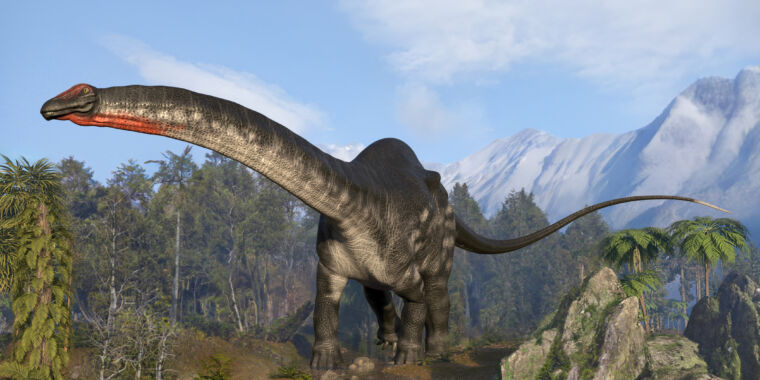
Words I didn’t expect to read in a scientific paper this week: “The similarity in mass and contact area between modern agricultural vehicles and sauropods begs the question: What was the mechanical impact of these prehistoric animals on land productivity?” The article, by Thomas Keller and Dani Or, may raise a major concern: Agricultural vehicles have grown in recent decades to the point that they can compact the underground soil where crop roots extend. This poses a risk to agricultural productivity.
The newspaper then compares that compaction risk with that of the largest animals that have ever roamed our country: sauropods.
The big crunch
We think of the soil as firm, but holes and channels in the soil are critical to plant life, as they allow air and water to reach the roots. Soil compaction, in its extreme form, takes away all of these spaces, making the soil much less hospitable to plants. And densification is hard to reverse; it can take decades of plant and animal activity to break down the compacted soil and restore a healthy ecosystem.
Much agricultural equipment is devoted to tilling the soil, breaking down the soil and improving the permeability of air and water. But this hardware doesn’t reach that deep. A “subsoil” area remains below the tilled soil, but the subsoil is still well within the area used by the roots of agricultural crops.
Obviously rolling something heavy on the ground is an easy recipe for compacting it. And agricultural hardware is getting heavier as larger equipment is more efficient. In 1958 a typical combine weighed about 4,000 kg. Today, that average weight has grown to over 35,000 kg. To avoid crushing the soil beneath this mass, tires have grown larger and operate at a lower pressure, allowing the tire to spread over a wider area to limit surface soil compaction.
But forces from the surface translate to the subsurface in a way that is less dependent on the area over which the compressive force is spread. Instead, the stresses at some depths depend largely on the mass per wheel. As such, the growing mass of combines (and other farm equipment) increases the risk of soil compaction. That effect will be difficult to detect and correct, but it could lead to a loss of agricultural productivity.
Global risks. And dinosaurs!
Compaction risks are not evenly distributed. Dry regions have less groundwater to extract and are therefore less at risk of compaction. Some countries also farm through smaller plots that don’t take advantage of the efficiencies offered by large hardware. Still, many areas are at risk of compaction, including the eastern US, eastern Australia, Argentina and much of Europe. Overall, these areas are in good agreement with those that a separate study has suggested suffer from reduced productivity due to soil compaction. In total, about 20 percent of important agricultural areas are at risk.
Which brings us back to the dinosaur problem. Sauropods became considerably more massive than even the largest harvesters – they may have approached 80,000 kg. Their weight was distributed over just four limbs, with footprints roughly comparable to those of modern tires (harvesters, on the other hand, often have six tires). Finally, in order to move, the sauropods had to lift at least one limb at a time. All these factors together mean that the sauropods should have exerted considerably more pressure on the bottom.
Now if farm equipment is a compaction risk, the dinosaurs were almost certainly causing problems. At the same time, however, animals of that size needed a thriving ecosystem to support them. “The potential for significant soil compaction by foraging sauropods seems incompatible with productive land supporting renewable vegetation for feeding these prehistoric herbivores,” as the researchers put it.
How to explain this apparent contradiction? Keller and Or, who both specialize in agricultural studies, turn to an idea that’s been popular in paleontological circles for some time: anything this large was almost certainly semi-aquatic, as it would struggle to support its bulk. But instead of talking to a paleontologist for more insights, the authors simply state that “solving this paradox is beyond the scope of this study.”
PNAS2022. DOI: 10.1073/pnas.2117699119pnas.org (About DOIs).

